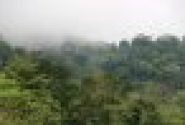BOGOR, Indonesia (22 November, 2012)_A team of researchers from the Center for International Forestry Research have been cramped in a small speedboat cruising along the South China Sea for eight hours. Suddenly the boat pauses, crossing a stark threshold where the silted brown water of the sea fuses with a darker, thick liquid.
“Air hitam,” says one of the local research assistants. “Black water”.
The black water is a sign that the researchers have reached Berbak National Park – one of the largest undisturbed peat swamp forests in South-East Asia and home to elusive species such as the Sumatran tiger and rhinoceros.
“Above the surface we have various endemic species that you cannot find anywhere else,” said Fransisco Moga, the former head of Berbak National Park.
“But beneath the surface, we have carbon-rich peatland.”
Found on the island of Sumatera in Indonesia, Berbak was once the realm of colonial hunters chasing exotic animals for their valuable pelts. Legislated as a protected area in 1935 under Dutch colonial law and later declared a national park, Berbak has recently been recognised as a wetland of international importance due to the huge amount of carbon it harbours in its soils.
“While peatland forests cover only threeper cent of the word’s surface, when cleared for other land uses such as oil palm plantations, they are responsible of 60-80% of greenhouse gas emissions generated from forests,” said Kristell Hergoualc’h, CIFOR scientist.
The potential for Berbak’s huge store of carbon to be released should the peat forest be disturbed has brought the region to the attention of policymakers in Indonesia, particularly those involved in the climate mitigation scheme Reducing Emissions from Deforestation and forest Degradation (REDD+). REDD+ will see developing countries financially rewarded for reducing their greenhouse gas emissions by keeping their forests standing (and their carbon stored).
Along with two other areas in Indonesia, Berbak was recently declared a national REDD+ demonstration site.
“We will use this area to assess the potential of carbon measuring in peatland forests,” Moga said.
CIFOR’s researchers have been working with park staff for the past two and a half years to measure and monitor carbon and other greenhouse gases emissions from the peat soils. Such data is helping Indonesia’s policymakers to design future interventions and forest management policies.
In a conversation with Forests News, Fransisco Moga recounts the history of Berbak National Park and how organisations such as CIFOR are helping to overcome challenges in protecting the park.
Q: Can you give a brief history of Berbak National Park?
Moga: Berbak National Park was established in 1935 during Dutch colonialism and was declared by the Dutch Government as a nature reserve because of its rich diversity, such as tigers, bears, tapir, and two species of crocodile: Sinyulung and Muara. In 1992, the nature reserve was formally established by the national government as Berbak National Park, constituting 162,000 hectares. Since its creation, the park has been focused on intensively managing the different ecosystems within its borders. The management of the park is coordinated by the Directorate General of Forest Protection and Nature Conservation (Dirjen PHKA). Later, we established the park boundaries so that management could be done more intensively, such as an inventory of its fauna, as well as other wildlife, such as birds inhabiting the park.
Why are peatlands so important for climate change in Indonesia?
The park is not only rich with fauna and flora, but 70% of the park area is rich with peatland forest, which was formally recognised as a RAMSAR site in 1991. The park’s peatland forests contain a huge amount of carbon, making the park important for both national and regional carbon management and climate change mitigation programmes. For these reasons, the Ministry of Forestry through Dirjen PHKA has declared Berbak National Park a national demonstration site for REDD+, which will be continuously monitored from 2010 through to 2014.
Why was Berbak Park scaled up from a REDD+ pilot project to a demonstration activity?
Berbak National Park was previously a pilot project but has since become a demonstration activity due to its potential to support REDD+ though carbon measuring of its peatland forests. This project has convinced stakeholders of the need to plan for intensive management of carbon sinks in the park’s peatland forests. The park also has other benefits, such as the existence of endangered animal species.
How are organisations like CIFOR and others working together with the national park to monitor carbon?
We have limited staff and capacity to conduct the research needed to measure the carbon found in peatlands in order to manage it more effectively. Therefore, we have been collaborating with the Zoological Society of London and CIFOR to conduct research and measurements. This has created more complete and variable data which examines peat depth and thickness – information that is vital for planning and implementation of REDD+ activities.
What are the biggest challenges in managing Berbak National Park?
The management of the park is conducted in three ways: there is the protection/security of the overall park area; preservation, which is preserving the existing endangered and endemic species such as the Sumatran tiger, bear and tapir, existing trees, as well as conducting relevant research activities; and developing nature-based tourism by facilitating visits to the park.
In all of these areas, we have challenges. In terms of protection, we currently have 15 forest policy personnel to secure the park, also supported by local communities, the police and the army. However, the park covers a large area and is directly adjacent to 32 villages, which puts huge pressure on resources from encroachment by illegal logging and local communities. However, we realise that this is part of our job and will do our best to secure the area, also in coordination with local police
For preservation, we are continuing our research on various species living in the park such as tiger, bear, crocodile, as well as tree species such as ramin, jelutung, etc. However, we also have limited capacity to manage and carry out research in the park. Therefore, we are open to learning and collaborating with other parties who have the capacity to support us in this area
We have developed the park’s tourism potential but access to the park through the rivers and sea is sometimes difficult and requires special and costly transportation. This is unavoidable problem but we are trying to do our best to solve the problem. .
How do you feel about the role that you play in consecrating the national park?
I am happy, optimistic and enthusiastic in doing my job because I am proud that Indonesia, especially Sumatra, has a wealth of resources both above and beneath the surface. Above the surface, we have various endemic species that you cannot find anywhere else. Beneath the surface, we have carbon-rich peatland which is an important part of REDD+. We are very proud to be appointed to protect this park and we are continuously learning to understand the situation. I hope that Berbak National Park will play an important role in conservation management, especially in Sumatra because of its huge potential to draw national and international attention.
We want you to share Forests News content, which is licensed under Creative Commons Attribution-NonCommercial-ShareAlike 4.0 International (CC BY-NC-SA 4.0). This means you are free to redistribute our material for non-commercial purposes. All we ask is that you give Forests News appropriate credit and link to the original Forests News content, indicate if changes were made, and distribute your contributions under the same Creative Commons license. You must notify Forests News if you repost, reprint or reuse our materials by contacting forestsnews@cifor-icraf.org.












